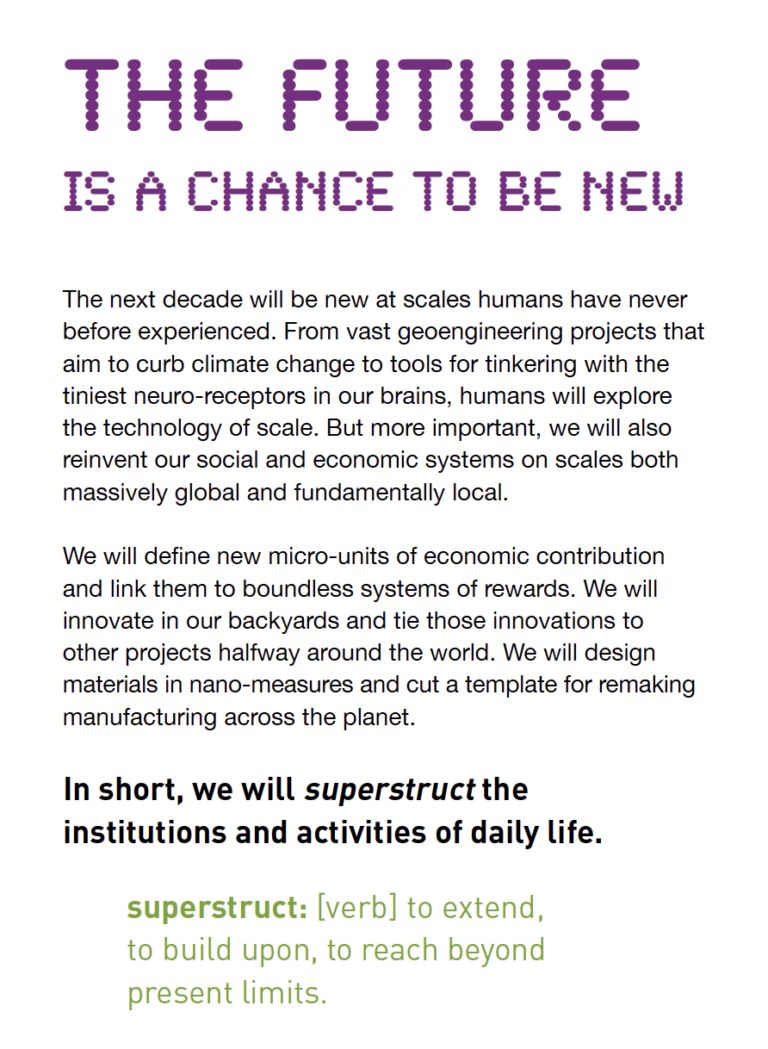2009 TYF: Superstructing the Next Decade
The Future is our chance to be new. The 2009 Ten-Year Forecast research delves into issues from a collapsing economy paving the way for new kinds of value to a new voice rising from the Global South plotting a new path for the next big economy to extreme climate conditions wiping the landscape clean to a new neuroscience presenting an extraordinary new picture of humans, and much much more. The Overview provides an intro to the Perspectives, Superstruct Handbook, Signal Survey, and the 2009 Map of the Decade. The Overview is also where you will find the 50-Year Outlook.
2009 Map of the Decade
This year’s map blends forecasts of innovation and disruption with a handful of Superstruct Ecologies—along with dozens of signals on the horizon-to create a map that features five big shifts: Extreme-Scale Collaboration, Alternative Wealth, Superstruct Ecologies, Mega-Structures, and A Governance Renaissance.
- Explore the Superstruct wiki: The Whole Superstruct Catalog
- Watch the Superstruct videos about GEAS: Global Extinction Awareness System
Ecologies
Illustrating the links among the many superstructures created by our 7000+ Superstruct players, the Superstruct Ecologies begin to depict possible future institutional landscapes.
Appleseed Ecology
Starting from a game that taps real-life gardens to advance urban farming through “simfarms”, this ecology describes a new infrastructure for securing food, repurposing waste, and creating new forms of exchange.
Natural Currency Ecology
This ecology re-envisions our capital systems as tied, not to gold or GDP or other commodities, but to environmental measures, linking sociability to sustainability.
Community Works Ecology
Recognizing thet “large-scale problems do not require large-scale solutions,” this ecology creates superstructures for replicating local solutions across large-scale systems.
Open Fab Initiative Ecology
The Open Fab Initiative is the starting node for a densely interconnected ecology of superstructures that explicitly link new very small-scale fabrication tools and practices to solving the problems of distressed communities-creating new local material and economic realities.
Quantum Governance Ecology
Building on the desire to create a new post-Newtonian model of governance, this ecology is thick with superstructures that help citizens make sense of the world-bridging across realities.
Strategies
The Superstruct game is not only a forecasting game designed to anticipate new kinds of superstructures. It’s also an experiment in superstructing. Out of the experiences of both the designers--the IFTF team--and the people who have played the game, seven basic strategies for superstructing have emerged.
Evolvability: Nurture genomic diversity and generational differences.
Extreme Scale: Layer micro and massive scales for rapid adaption.
Ambient Collaboration: Leverage stigmergy with environmental feedback.
Reverse Scarcity: Use renewable and diverse resources as rewards.
Amplified Optimism: Link amplified individuals at massive scales.
Adaptive Emotions: Confer evolutionary advantage with awe, appreciation, and wonder.
Playtests: Challenge everything and everyone in fun, fierce bursts.
Perspectives
The perspectives take a closer look at 5 of the forecasts from our 2009 Map of the Decade. Each perspective includes an analysis of the forecast, an interview with an expert, and examples of what superstructing this perspective looks like.
Design: Post-Newtonian Governance
The Newtonian politics that emerged at the end of the 18th century were a triumph of human ingenuity and foresight, applying the latest technologies and a scientific understanding of the universe to the design of governance. However, there has been little true innovation in governance since the creation of the U.S. Constitution. All that is about to change.
Civil Society: Networked Citizens
The citizen of the future is a native of the network; and that changes everything. It tempers border-based identities. It refocuses political action on issues that are both more local and more global at the same time. It links expressiveness to empowerment and turns the smart consumers of the early Internet era into activist citizens of the coming decades.
Environment: Geoengineering
With broad scientific consensus that global warming requires deep cuts in carbon emissions, what remains unanswered is the question of whether we’ll have enough time to implement the economic, social, and technological changes necessary to reduce our carbon footprint. In the face of massive, irreversible changes in our living ecologies, a growing number of scientists have a backup plan: large-scale geoengineering.
Culture: Superstructed Realities
As physical and digital realities are seamlessly integrated, cyberspace is not a place that people go; it’s a new layer in their reality. It’s a superstructure of that will serve as our outboard brains and senses, remaking the basic concept of self and changing how we keep ourselves physically sound.
Cognition: Beyond FOXP2
It’s been at least 40,000 years since modern humans-Homo sapiens-became the only sapient life on earth, set apart by a critical mutation in the so-called language gene, FOXP2. But that isolation won’t last much longer. In a quest to augment our own intelligence with biotechnology and digital tools, our first experiments are re-engineering animal brains. What happens when we “uplift” our fellow species and potentially create a new cross-species politics?
Ten-Year Forecast Signals Survey
Using more traditional survey research methods, this Signal Survey probed the edges of innovation with questions about personal avatars in online virtual worlds, about mobile health practices, sustainable medicine, new forms of political engagement, and the kinds of bonds that form so-called “new diasporas.” The survey results point to the waves of social innovation we can expect in the coming decade.
50-Year Outlook
The choices we make make in the next decade will set the course for the century. Likewise, our visions of what the world could be in 30 or 50 years shape the decisions we make today, both directly and indirectly. Looking long, we offer the following three scenarios:
- The Long Crisis plots a path of slow response, resistance to change, and attempts to maintain current power relationships,
- Emergence follows a course of rapid adaptation from the bottom-up, without much unifying direction,
- The Great Transition envisions a world re-made by technology, a challenge to the planetary dominance of humans as a species.

